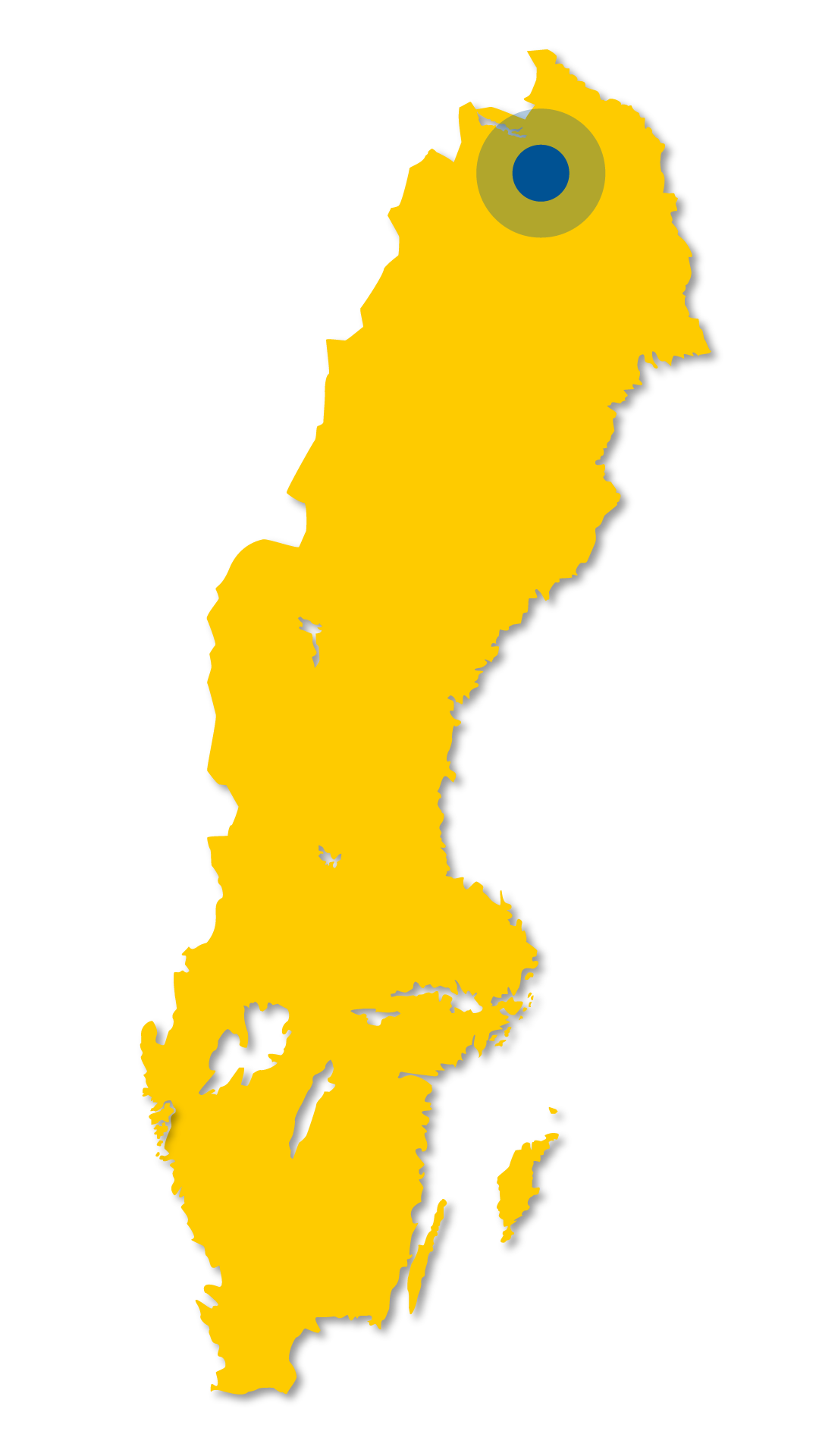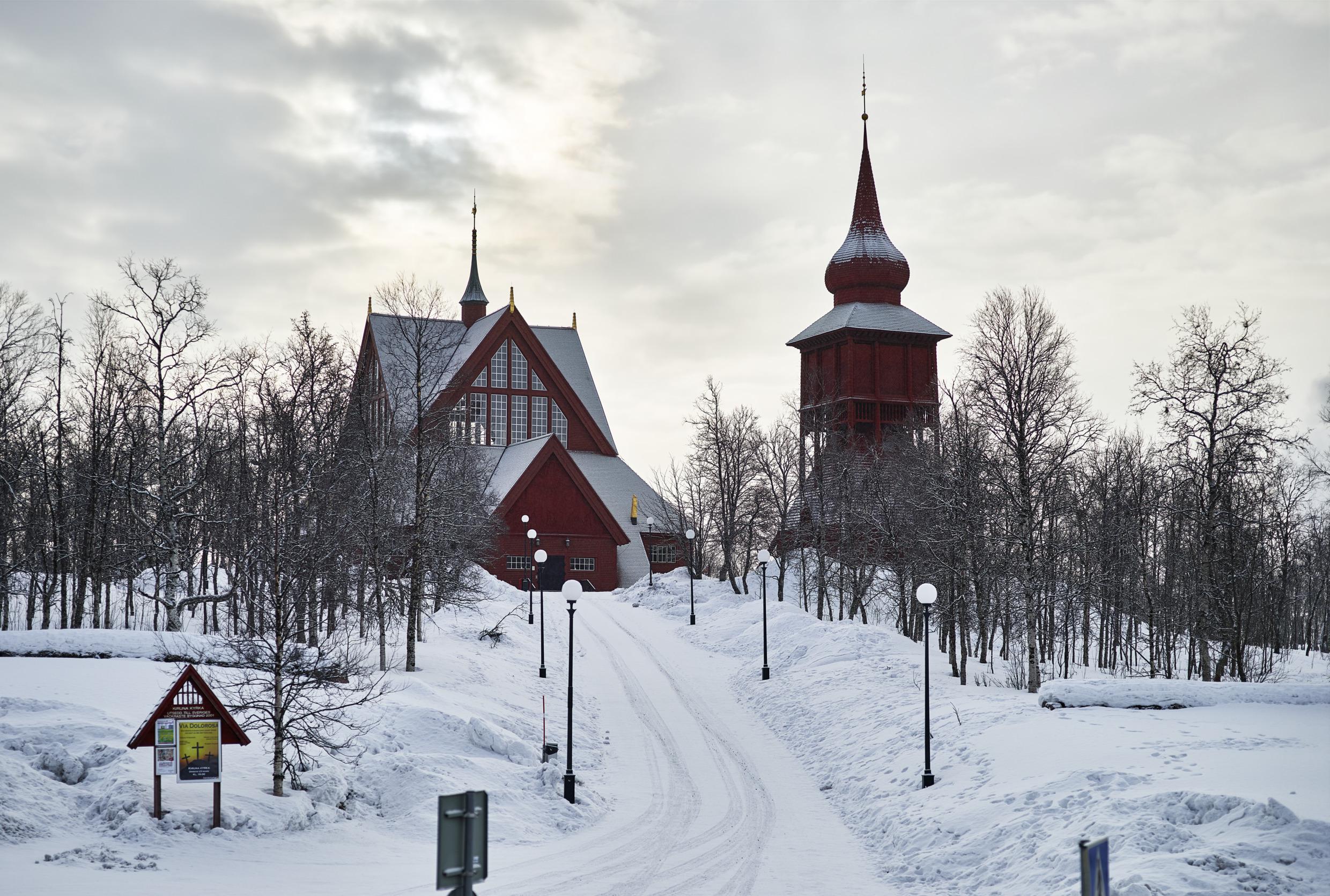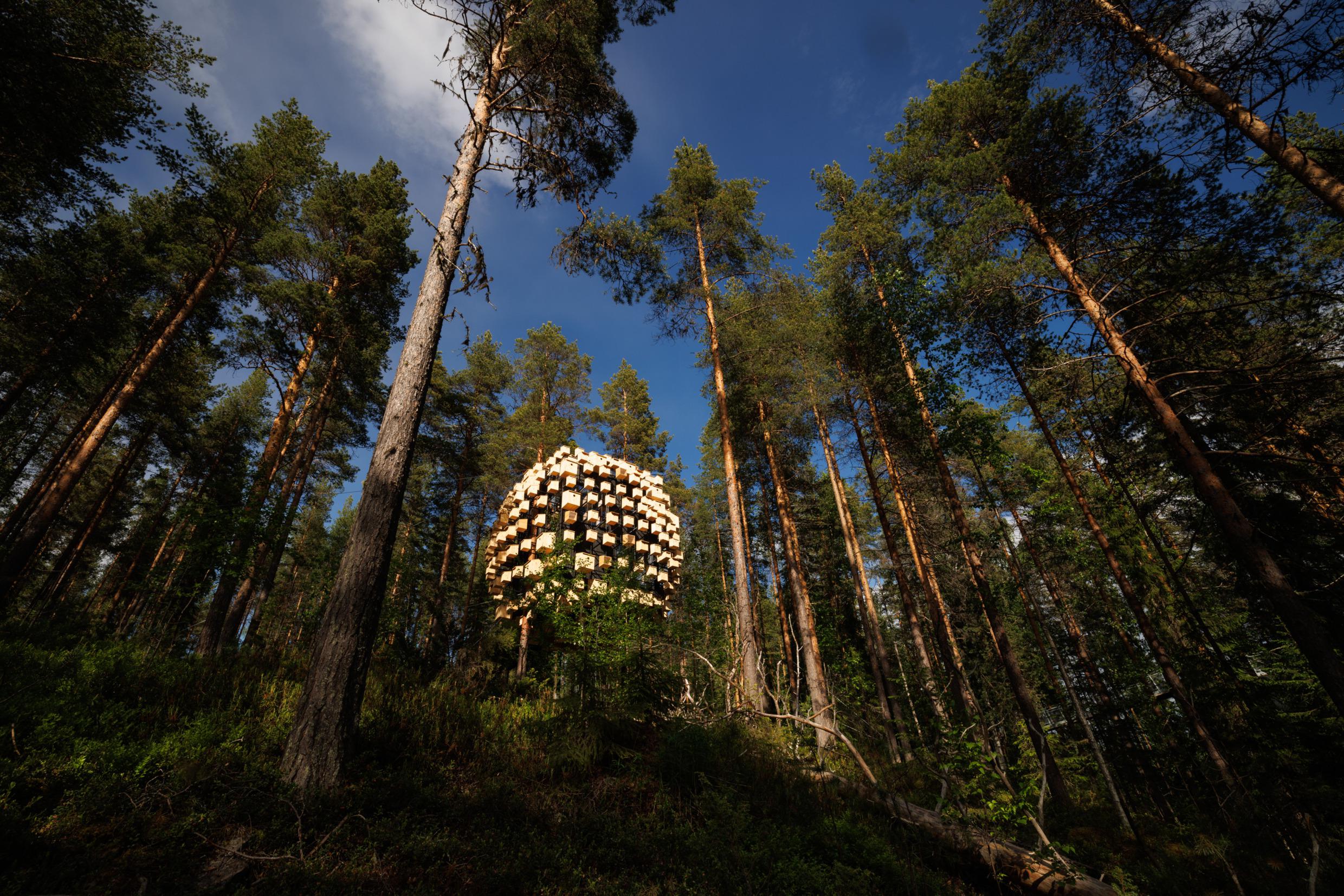

Kiruna – an arctic city bathed in the Northern Lights
Kiruna – Sweden’s northernmost city – has a lot to offer. This is where to see the Northern Lights and experience the Midnight Sun. It also boasts Kebnekaise, Sweden’s highest mountain.
Nestling some 200 kilometres north of the Arctic Circle, Kiruna is a gem of a city that forms part of Swedish Lapland – an enormous area covering about a quarter of Sweden. Kiruna also has cultural and historical significance as part of Sápmi – the traditional home of the indigenous Sámi people – that extends beyond the national border.
An outdoor enthusiast’s dream destination, Kiruna is surrounded by varied and vast terrain – from deep forests and expansive marshes to lakes, rivers and mountains – including Kebnekaise, Sweden’s highest mountain. These landscapes are ideal for activities such as hiking, fly fishing, skiing, snowshoe walking and dog sledding.
Kiruna is fascinating from an urban perspective. This historic mining community – first established in 1900 – is undergoing a transformation due to the impact that the mining has on the area. For the mining to be able to continue, the physical lifting and shifting of buildings – and the occasional demolishing and erecting of others – is well underway.
Due to the city transformation, Kiruna Church will be moved in one piece in 2025 to a new location between the cemetery and the new city centre. The church will be closed from the summer of 2024 until the opening at the new location at the end of 2026.
Kiruna’s city centre stood ready in its new position on 1 September 2022, and Kiruna City Hall – a completely new building known as “the crystal” – was the first landmark to appear. The rest of the move is due to be completed by 2035.
There’s plenty to discover in this compelling city of transformation and if a roadtrip in Kiruna is on the agenda, you won’t have to venture far before reaching gems such as the Icehotel, Kebnekaise and Abisko – all located within the municipality.
Icehotel, Jukkasjärvi
The Icehotel is situated 200 kilometres north of the Arctic Circle in Sweden. It is constructed entirely from ice and contains hotel rooms, a bar and art exhibitions. Quite often, guests who go outside will catch the natural phenomena of northern lights.
Photo: Asaf Kliger/Ice Hotel

Icehotel, Jukkasjärvi
Photo: Asaf Kliger/Ice Hotel

Abisko Nationalpark
Photo: Katja Kristoferson/Folio/imagebank.sweden.se

Mountain peak
Photo: Felix Oppenheim/Folio/imagebank.sweden.se

Kiruna mining town
Photo: Jann Lipka/imagebank.sweden.se

Aurora Sky Station
Photo: Ted Logart/Swedish Lapland

Midnight sun in Swedish Lapland
Photo: Markus Alatalo
Kiruna and the Northern Lights
Kiruna is synonymous with the Northern Lights, the Midnight Sun and other natural phenomena, not least, the Polar Night. This four-week period in December and the first few days of January sees Kiruna – and other places north of the Arctic Circle – stranded in near constant darkness. The sun doesn’t rise above the horizon but it is never pitch black, thanks to the snow, the light from the moon and the “blue hour”. Despite the name, this is a short period of some 15 minutes of twilight each day, when the sun is just below the horizon and the sky takes on a deep blue appearance.
Seeing the Northern Lights meanwhile, is an unforgettable experience. You can catch this kaleidoscopic display in various places, perhaps as part of one of the many outdoor activities setting off from the city. The Aurora Sky Station in Abisko – an hour’s drive from central Kiruna – is known as one of the best places in the world to admire it. You’ll only be able to see it when it’s dark from September to March though.
At the other end of the spectrum, the Midnight Sun is the 24/7 sunlight you get here in summertime. Plan your trip between late May and mid-July if you don’t want to miss it. You can also combine the experience with skiing as late as Midsummer in the Riksgränsen ski resort.
Hiking the King's Trail, Swedish Lapland
Don't forget a sturdy pair of boots and waterproof clothing during your hike on the King's Trail in Swedish Lapland.
Photo: Ted Logart/Swedish Lapland

Hiking the King's Trail, Swedish Lapland
Photo: Ted Logart/Swedish Lapland

Scandinavian mountains
Photo: Anders Ekholm/Folio/imagebank.sweden.se

Three-Country Cairn
Photo: Jerker Andersson/Imagebank.sweden.se

Fly fishing, Swedish Lapland
Photo: Ted Logard/Swedish Lapland

Dog sledding adventure
Photo: Anna Öhlund/imagebank.sweden.se
An ultimate hotspot for outdoor nature activities
Take advantage of the long days by hiking along the famous King’s Trail (Kungsleden). The section extending from Abisko to Nikkaluokta takes you through the lake-studded Abisko National Park. Kebnekaise is one of the trail’s star attractions. Hikers should also consider the Three Country Cairn trail (Treriksröset), taking its name from Sweden's northernmost spot – the cairn that divides Sweden, Norway and Finland.
With thousands of lakes and numerous major rivers, Kiruna is a flyfishing paradise. The clear waters are inhabited by species such as Arctic Char, pike, whitefish, grayling and salmon. There is a range of guided fishing tours on offer – complete with fishing licence – lasting from a few hours to several days. Ice-fishing is another ideal Kiruna experience and there are activities aplenty to choose from.
As for other wintertime experiences, dog sledding is a definite highlight. Huskies are a joy to spend time with and there are various tours and activities to choose from. Set off on your own like a true musher or sit back and relax. You’ll find dog sledding information and activities here.
Sami
The Sami people have their own folk costume, the kolt. The traditionally blue costumes have at least 12 different styles and differ for men and women.
Photo: Lola Akinmade Åkerström/imagebank.sweden.se

Sami
Photo: Lola Akinmade Åkerström/imagebank.sweden.se

Sami culture
Photo: Anna Öhlund/imagebank.sweden.se

Kiruna Church
Photo: Hans-Olof Utsi/imagebank.sweden.se

Kiruna City Hall
Photo: Henning Larsen Hufton + Crow/Kiruna Kommun

Mining in Sweden
Photo: Sonia Jansson/imagebank.sweden.se
Kiruna's cultural identity – and some of the activities embracing it
The region around Kiruna known as Sápmi – the land of the Sámi people – stretches across the very north of Sweden, Norway, Finland and Russia. Sweden’s indigenous people have inhabited the region for thousands of years. Reindeer herding is a major Sámi industry and don’t be surprised if you come across herds of these beautiful, placid animals when out in nature. If so, take care to keep your distance so as not to disturb them.
Authentic Sámi experiences are on offer courtesy of a number of hosts. Nutti Sámi Siida and Giron Reindeer, for instance, invite you to learn about reindeer herding via a range of experiences, which differ depending on season and incorporate additional aspects of Sámi culture.
Back in the city, guided tours will take you through Kiruna’s new urban landscape and continuous shifting. North Sweden Tourism, Kiruna Storytelling and Guide i Norr organise tours – all compelling and each with its own direction.
Don’t miss the opportunity to go underground to explore the LKAB mine – the world’s largest underground iron-ore mine. The tour and informative visitor centre sheds light on the mine's century-long history and current mining production – as well as its role in the city’s move and much more.
Sámi food
Cooking reindeer meat, or ‘suovas’, over an open fire during a Sámi cultural experience organised by Nutti Sámi Siida in Swedish Lapland. The company organises eco Sámi adventures all year around in Jukkasjärvi, in Swedish Lapland.
Photo: Anna Öhlund/imagebank.sweden.se

Sámi food
Photo: Anna Öhlund/imagebank.sweden.se

Reindeer meat
Photo: Pernilla Ahlsén/imagebank.sweden.se

Stejk Street Food
Photo: Tobias Stjernström
Kiruna on a plate – local specialities and where to find them
Kiruna’s culinary identity is influenced by Sámi food traditions. Local produce and ingredients harvested from nature form an important part of the diet. Reindeer meat comes in many forms, including sausages and smoked steak, and you’ll also come across elk meat. Fish from local waters appear on many restaurant menus and be sure to try Kalix Caviar. This was the first Swedish produce to receive Protected Designation of Origin (PDO) status by the EU, joining the ranks of Champagne and Stilton Cheese.
Restaurants serving up the best of the region, with sustainability front and centre, include Spill Saluhall & Eatery. This restaurant/deli offers local specialities. In a similar vein, Mommas, housed in Scandic Kiruna hotel, has a menu based on regional flavours.
Stejk Street Food offers casual dishes made from locally sourced ingredients. Add an extra pinch of local flavour to the experience by taking a seat in its cosy lavvu, the Sámi equivalent of a tepee.
As for drinks, keep an eye out for brews by Kiruna Bryggeri, available in most local restaurants and bars, allowing you to complete the local experience.
Practical information before your trip to Kiruna
Scandic Kiruna, Swedish Lapland
Admire the beautiful surroundings from Scandic Kiruna's sky bar. The hotel is located in the city’s new downtown district and is inspired by Sweden’s highest mountain Kebnekaise.
Photo: Scandic Hotels

Scandic Kiruna, Swedish Lapland
Photo: Scandic Hotels

Camp Ripan, Kiruna
Photo: Jonas Sundberg/Camp Ripan

Skiing, Riksgränsen
Photo: Lapland Resorts/Matti Rapila
Design & ArchitectureDesign & Architecture
Nature & OutdoorsNature & Outdoors

Kayaking and canoe adventures in Sweden

The King's Trail has something for everyone

Top 8 lake vacations in Sweden – from wild swimming to kayak adventures

True adventure in Laponia

When and where to see the magical Northern Lights

When and where to see the magical Midnight Sun










